Contents
Introduction
Clients want a holistic view of all accounts, assets, and liabilities to allow fully informed decision-making. To further support your efforts to become the single source for your clients' holistic financial data, we offer the Envestnet | Yodlee integration, which allows you to aggregate held-away accounts, assets, and liabilities.
With this integration, you and your clients can add and see outside accounts—examples include credit cards, investments, loans, and mortgages—on the Net Worth report and on the client portal. This type of account aggregation allows you to track total net worth and provide a holistic view of a Household's financial situation.

Envestnet | Yodlee includes a network of over 15,000 connections to financial institutions, billers, reward networks, and other end points—including a connection to automatically determine the value of a home.
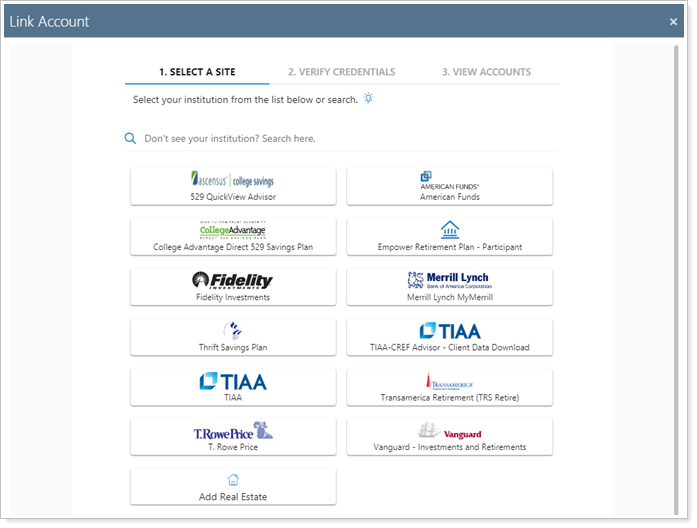
What You Can Do With This Integration
With this integration, you can do the following:
-
Link balance-only, APD, and reconciled accounts to get account data that's updated daily. Learn More >>
-
See all of your clients' financial accounts summarized on the Net Worth report, including held-away accounts.
-
Add outside reconciled accounts in all available dynamic, PDF, and client portal reports. Learn More >>
Enrollment
If you'd like to take advantage of the Envestnet | Yodlee outside account aggregation integration features, email TamaracAM@envestnet.com to learn about the associated cost.
Manage the Yodlee Integration
Account aggregation using the Yodlee integration provides a powerful tool for tracking total net worth at one date or over time, as well as providing a holistic view of a Household's financial situation.

When accounts are successfully linked, they will begin displaying the account value as of the previous market close.
For more information on transaction accounts and linking accounts, see Learn More About Linked Accounts.
Places You can Add, Edit, or Delete a Linked Account
You can add linked accounts in the following locations:
-
On the Aggregated Accounts page. For more information, see Link, Edit, or Unlink Accounts on the Aggregated Accounts Page.
-
In the Household. For more information, see Link, Edit, or Unlink Accounts on the Households Page.
-
On the Client Portal and mobile app. For more information, see Link, Edit, or Unlink Accounts on the Client Portal.
Best Practice
Enable add/edit linked accounts for your clients on their Client Portals. This avoids potential custody issues by allowing clients to establish and maintain linked accounts themselves.
If clients are not confident about following these steps independently, set aside time in a meeting to walk through the steps together. Steps are the same for advisors and clients.
Add an Automatic Real Estate Estimate
You can use the Yodlee integration to provide estimates for the value of real estate. This estimate automatically updates based on the current market value, saving you from having to manually maintain real estate holdings values and increasing the overall accuracy of your net worth tracking.
Note
Linked real estate values do not update daily. Instead, they update once per month. This update occurs between the 10th and the 15th of every month.
To add a new real estate valuation estimate:
-
Under Accounts, click Households.
-
Click on the Household with the linked assets.
-
Click the Assets/Liabilities tab.
-
Click Link Outside Accounts.

-
In Select Client to Link Outside Accounts, choose the client from the list. You can only add accounts for clients associated with the Household.
Note
Clients skip this step. Assets or liabilities added by an individual client through their portal will be assigned to that client as Primary Owner.
-
In the Link Account window, scroll to the bottom and click Add Real Estate.
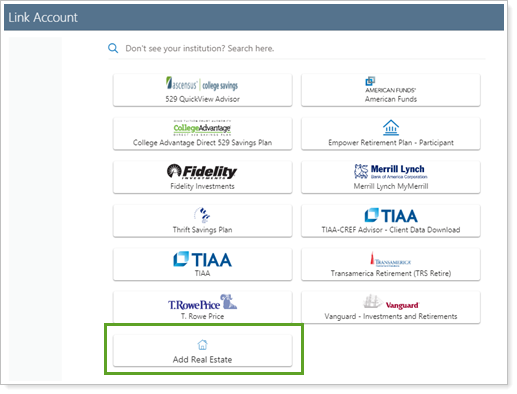
-
Complete the following fields:
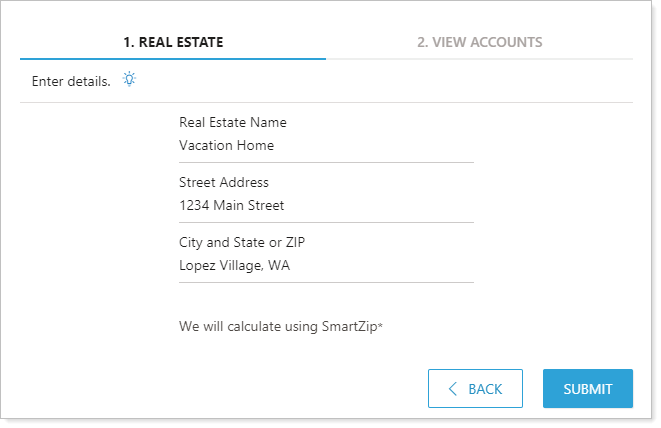
Field Account Name This is the name for the account that will show up on the Assets/Liabilities panel and in the Net Worth report. Calculate Automatically/Enter Value Select Calculate Automatically to have the value of the real estate automatically update daily. Select Enter Value to enter a one-time manual value. You will have to update as the value changes in the future.
Street Address Enter the street address of the property. This is used to look up the value for the property.
If the address has multiple matches or is not an exact match, you can select the suggested address, keep using the address as entered, or edit the address.
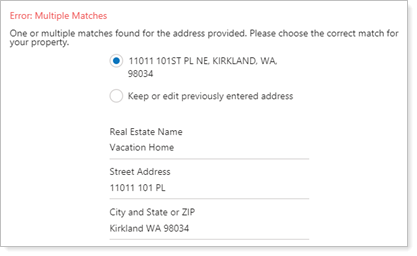
City and State or ZIP Enter the city and state or the Zip Code for the property. Include in Net Worth Toggle on to show the real estate estimate in the Net Worth report.
Toggle off to hide the real estate estimate from the Net Worth report.
-
Click Submit.
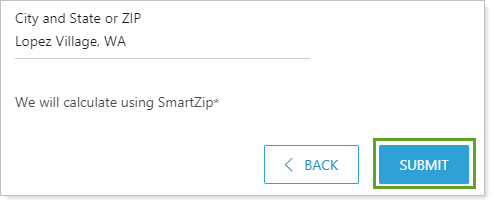
-
If you're done, click Finished. To add another home value or to link another external account, click Link Another Site.
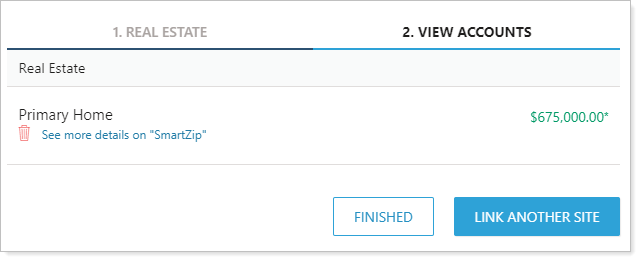
-
The linked real estate is added to the list of Assets as an Other Asset. If you want to edit it to change the Type or other details, click Edit. Otherwise, click Save.
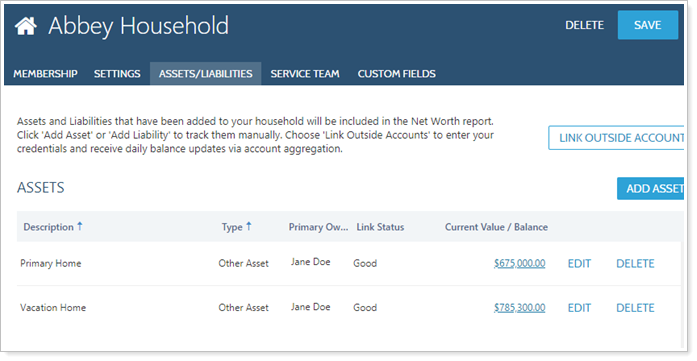
Check Asset/Liability Link Status
To help you manage linked accounts, the Link Status column on the Aggregated Accounts page shows the current status of the link between the external account and Tamarac.
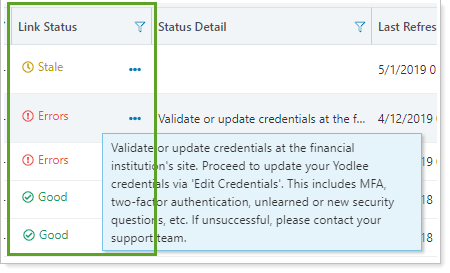
These are the possible statuses you might see for accounts found on the Aggregated Accounts page:
| Status | Meaning |
|---|---|

|
Errors can have various causes. Refer to the message in the Status Detail column for details. Possible resolutions for accounts with errors include:
Contact your dedicated service team for additional assistance. |

|
The account is successfully mapped to an account in Tamarac but it has not been refreshed within the last business day. To resolve this message, refresh the account manually. |

|
The account is successfully mapped to an account in Tamarac and it was refreshed within the last business day. |

|
The account is not yet mapped to an account in Tamarac, but it was refreshed within the last business day. It is common to see this status on accounts that are in the process of being converted from balance-only to reconciled accounts. Be aware that accounts are converted during your nightly sync. It can take up to 24 hours for balance-only accounts to convert to reconciled accounts. |

|
After you click Refresh Status, you may see this message while Tamarac is refreshing the link status for that custodian. |

|
The account is in the process of being unlinked. |

|
The account has been unlinked but will remain displayed for historical purposes. |
View Linked Accounts
Once you've linked held-away assets, liabilities, or investment accounts using Yodlee, you can see those linked accounts in the following locations in Tamarac.
On the Net Worth Report
Linked balance-only accounts are displayed in the Net Worth report the same as manually-entered assets or liabilities.
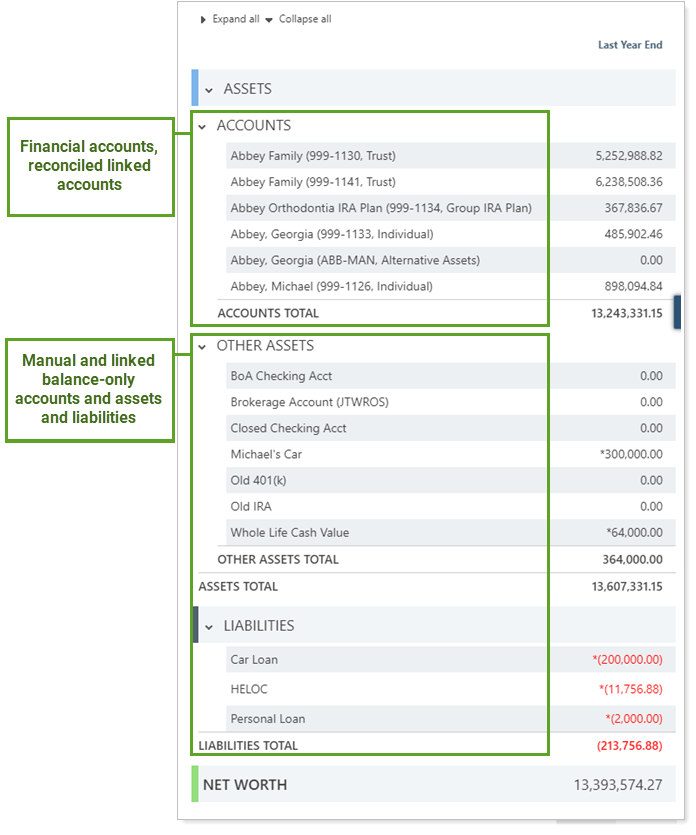
As with all assets and liabilities, linked accounts will be sorted according to the Asset Type selected.
Note
Linked accounts automatically come in with an Asset Type of Other Asset. Edit the Asset Type as applicable to ensure assets and liabilities are accurately sorted in the Net Worth report.
on the Aggregated Accounts Page
The Aggregated Accounts page displays reconciled account information, including client, custodian, current value, and link status.
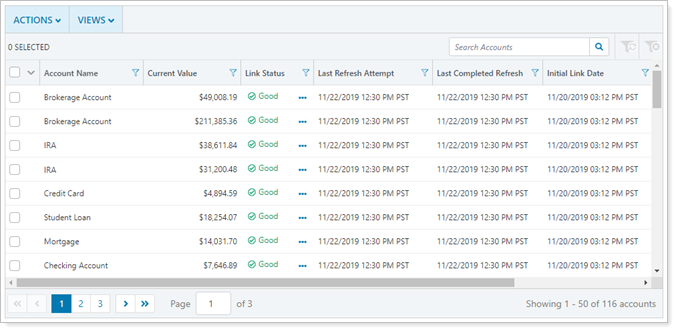
Important
If you've previously used the Clients page to monitor linking or used the Yodlee tab on the client record to see reconciled accounts, both of these features are now available on the Aggregated Accounts page.
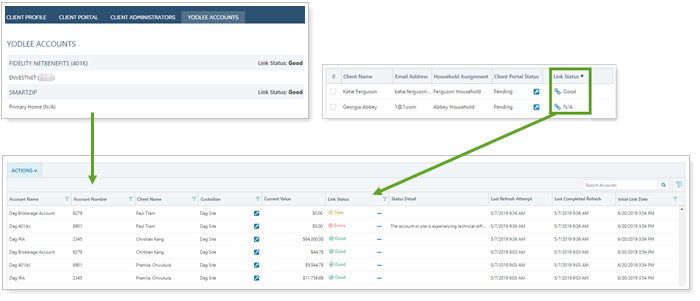
For more information on the Aggregated Accounts page, see Using Views and Filters on The Aggregated Accounts Page.
For a Household
When external financial accounts are linked, you can see them listed under the Household in on the Assets/Liabilities tab. Like manually entered assets and liabilities, you can edit any of the information about the account, including adding balance history.
Note
We recommend you manage all linked accounts, both balance-only and reconciled, on the Aggregated Accounts page. For more information, see Using Views and Filters on The Aggregated Accounts Page.
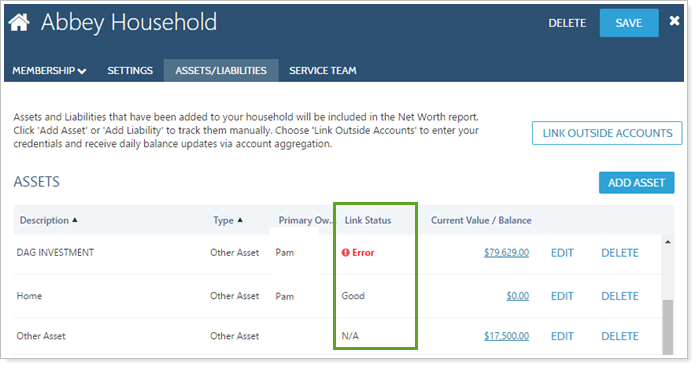
To review the account's balance history, the Assets/Liabilities tab, next to the desired asset or liability, click Edit. Then click the Balance History tab.
For more information, see Assets and Liabilities and The Households Page.
As a client on the Client Portal
You can allow clients to view and edit linked accounts through the client portal. Clients will receive link error notices and have the opportunity to resolve them, as well as see and add their own held-away accounts.
For steps on how your client adds assets and liabilities on the client portal, see Manually Add Assets and Liabilities From the Client Portal.
To enable client portal account linking:
-
Under Client Reporting, click Client Views.
-
Click Reports/Pages.
-
From the Report and Page Types list, select Assets/Liabilities.
-
Select the Allow clients to manually add and edit assets and liabilities check box. Then select the Allow clients to link accounts as assets and liabilities check box. For more information about the settings on this page, see Client Views - Assets and Liabilities Page.

-
Click Save.
The primary place where clients will see aggregated accounts is in the Assets/Liabilities page, which they can access from the Accounts menu. For more information, see Use the Client Portal Assets & Liabilities Page.
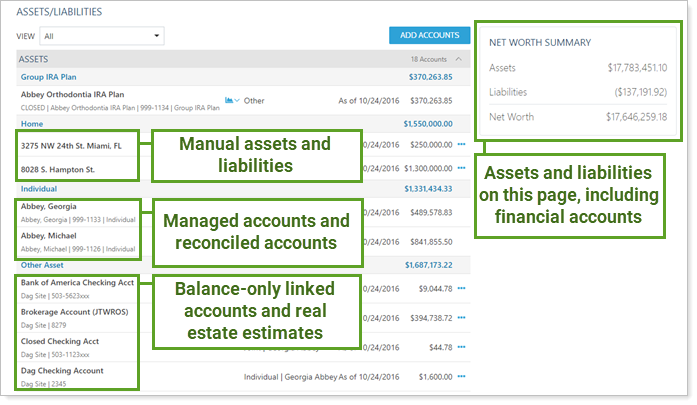
Clients readily access the Assets & Liabilities page in the client portal from:
-
The Accounts menu.
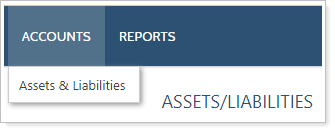
-
The Net Worth report, using the new Manage Accounts button.
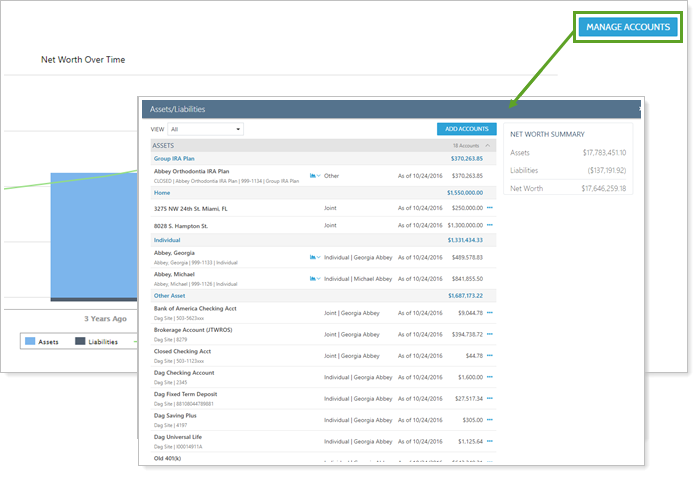
Clients also see linked assets and liabilities on the Net Worth report, which can be viewed from the client portal under Reports by clicking on Net Worth.
Note
You can also add the Net Worth report to the client portal Dashboard. For more information, see Client Views - Dashboard Page.
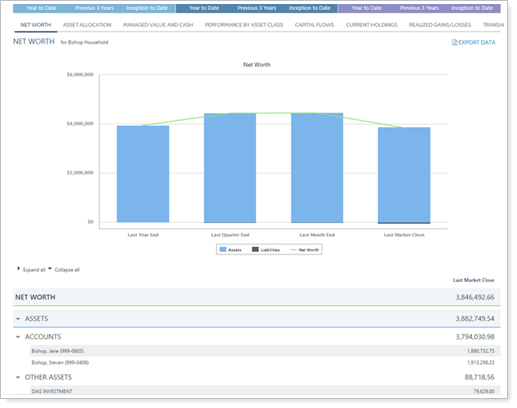
Note
When viewing the client portal as your client sees it, it is recommended that advisors do not edit assets or liabilities.

Troubleshoot Yodlee Integration
The following section provides some basic troubleshooting and information on the types of errors you may see when working with the Yodlee integration.
Best Practice
Clients are best suited to resolve most integration errors since they own the accounts and can address dual factor authentication requirements, login credential changes, or similar issues.
Link Status says "Errors"
You and your clients will both receive notifications when there are issues with a link. Your clients will see an alert when they log in to the client portal. Clicking on the alert icon will open the announcement and provide a link to the Assets/Liabilities page on the portal.

You will see error messages in Advisor View on the Aggregated Accounts page in the Link Status column and on the Assets/Liabilities panel of the Household holding the account.
-
On the Aggregated Accounts page, see the Status Detail column to learn more about how to resolve the error.

-
On the Household's Assets/Liabilities panel, click the error to get more information on how to resolve the problem.

The following are possible error messages on the Household Assets/Liabilities tab and how to resolve them:
Error Message Issue Resolution 
Login credentials are out of date. For example, the password may have expired.
Click Update Credentials. Enter the new credentials.
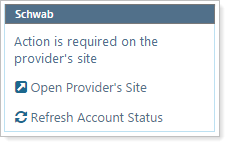
Something has changed on the financial institution's site. For example, the client may have to agree to new terms and conditions on the provider's site.
-
Click Open Provider's Site and address the issue.
-
Click Refresh Account Status.

There is something wrong with the provider's website or the link on their end.
Contact your Tamarac Service Team for more information.
-
Clients see two types of errors on the Assets & Liabilities page:
-
Actionable errors: Marked with
 . Clients can resolve these errors. Example: Updating login credentials or provider site URL change.
. Clients can resolve these errors. Example: Updating login credentials or provider site URL change. -
Informational Errors: Marked with
 . Only you, the advisor, can resolve these errors. Example: Reconciled account mismatching or APD account credential issues.
. Only you, the advisor, can resolve these errors. Example: Reconciled account mismatching or APD account credential issues.
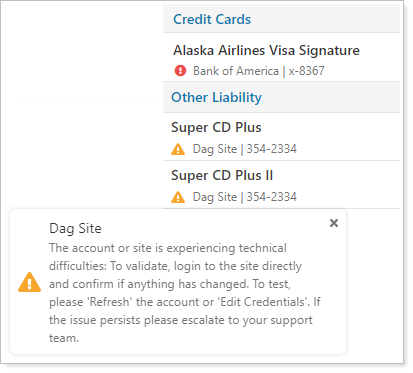
Can't find financial institution
If searching by name doesn't bring up the institution you are looking for, try the following.
| Issue | Resolution |
|---|---|
| Search by a less specific term. |
Sometimes the name may not be entered in the Yodlee database identically to how you are entering it. |
| Search by URL. |
Navigate to the financial institution's website directly, then copy and paste that URL directly into the search bar. NoteYou must remove the https://www. from the front of the URL. |
Login credentials don't work
If you enter login credentials and they don't work, the following may help resolve the issue.
| Issue | Resolution |
|---|---|
| Confirm the credentials are correct. |
Try logging in at the provider's website using those same credentials. This confirms that the credentials are correct and allows you to address any issues that may arise on the provider's site. |
| Confirm the password is entered correctly. |
To ensure that the password is entered correctly, click Show in the password fields. This converts the password from being obscured to clear text.
|
| Check for dual factor authentication. |
If the client has dual factor authentication enabled on the financial institution's site, in the Verify Credential step, you must additionally enter their enter the phone number or email address where the code is sent. Then, when the security code is sent to the client, enter it and click Next to complete the link. |



